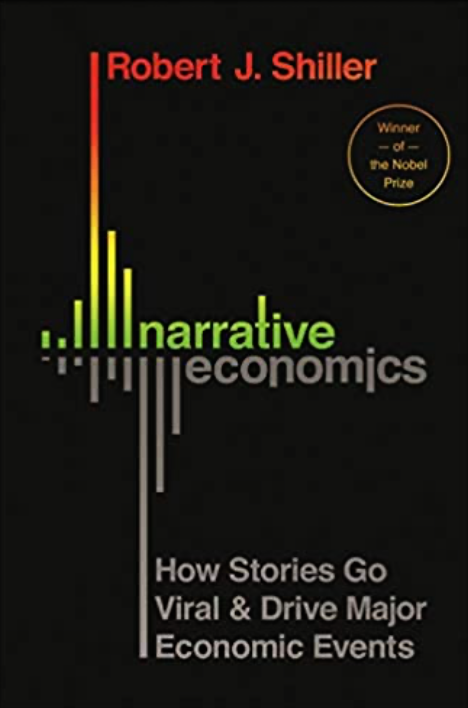Narrative Economics: Innovative Approach to Complex Topics
Narrative Economics, Robert James Shiller’s 2019 book on viral stories as essential economic indicators. Drawing on his lifelong work with behavioral economics, Shiller argues that viral stories, propelled by the media and word of mouth, move markets. “We can’t avoid using our human judgment about narratives for optimal understanding of economic events,” Shiller in Narrative Economics, page 16.
“Most people have little or nothing to say if you ask them to explain their objectives or philosophy of life, but they brighten at the opportunity to tell personal stories.” In his most recent book, Narrative Economics, Robert James Shiller, a Nobel prize-winning economist and New York Times best-selling author, presents narratives and contagious stories as an essential factor in understanding and predicting the economy. Through the inclusion of historical examples and statistical data, Shiller argues that studying popular stories that affect individual and collective behavior is a crucial element that has been overlooked in economic analysis. Narrative Economics is a fantastic read that is suitable for economics and literary fanatics alike due to its excellent structure, appealing writing style, and overall insightful approach to economic theory. Shiller’s commentary throughout the book truly allows readers to understand the economy from a new perspective and question their role within contagious narratives.
Shiller employs an excellent structure throughout the book to expose a complex economic theory in a comprehensible way. Narrative Economics is divided into four main sections, with a total of 19 chapters. The first two sections explore the overall concept of narrative economics and touch on topics like virality, causality, and narrative constellations. Meanwhile, the third section is dedicated to specific examples where the influence of economic narrative is evident. Some of these examples include real estate booms and busts, stock market bubbles, and labor unions. Similar to Narrative Economics, Nate Silver’s The Signal and the Noise also uses common topics and historical examples to prove its central point about humans’ forecasting nature. However, Narrative Economics dedicates the first part of the book to explain the concept of narratives before including the examples. In contrast, The Signal and the Noise explains the idea of predictions within the examples. Both books have structures that make them fun to read. Regardless, in Narrative Economics, the audience vastly understands the central topic in the first part of the book, making the chapters with the examples much more powerful. Essentially, the structure developed by Shiller not only makes the book more interesting to read but also makes the overall argument stronger.
Furthermore, Narrative Economics is an amazing read due to its insightful approach to economic theory. Predominantly, the book seeks to highlight the power of contagious narratives in driving markets and the economy as a whole. Shiller presents narrative economics as a new approach to behavioral economics, which is visionary and eye-opening for the audience. Most importantly, readers are encouraged to analyze their own economic behavior and question the narratives they are influenced by and the ones they help spread. At times, it seems like the author argues that the analysis of narratives is the only factor that is important when understanding and predicting economic events. However, the reader comprehends that Shiller is not overlooking other critical economic indicators; he is simply not interested in making these other factors a central part of the book. Similar to Narrative Economics, Abhijit V. Banerjee and Esther Duflo’s Good Economics for Hard Times also takes on the central premise that classical economic theory and macroeconomic indicators are not enough to truly understand economic behavior and societal issues. Both books advocate for a more holistic approach to economics, in which other perspectives and factors are considered. In Narrative Economics, the premise of viral stories as essential market propellers is innovative and allows readers to comprehend economic concepts from a new perspective.
Finally, seeking to make his economic insight entertaining, Shiller develops a captivating and friendly writing style. Primarily, narrative economics is explained through analogies. The author constantly draws to epidemiology concepts to help readers understand the contagion and extinction of viral stories. This field is relatable, especially during the COVID-19 pandemic, and allows complex topics to be fully understood. Similarly, Narrative Economics constantly includes data and evidence, particularly through graphs and historical texts. These enable the audience to understand the virality of certain narratives and help build the author’s credibility by demonstrating his extensive research. Some may argue the book can get too technical since it’s presenting an economic theory. However, Shiller makes excellent use of side notes to both expand and clarify the topic. Another of Shiller’s books, Animal Spirits, written alongside George Akerlof, also explores economics from a behavioral perspective, but it’s more fact-based than Narrative Economics. Such inclusion of extensive data can make the argument seem more credible, but it also makes the overall claim challenging to understand. Conversely, Narrative Economics includes the right amount of facts, as these do not overwhelm the reader. Overall, such use of data, combined with the use of analogies, graphs, and side notes, creates an appealing writing style that makes the book thoroughly entertaining.
Considering Shiller’s insightful approach to economic theory and his expert analysis regarding contagious stories, Narrative Economics is more than just another economics book. Its excellent structure and appealing writing style allow every typical reader to comprehend complex economics concepts. Most importantly, the book’s overall assertion leads the audience to question their own role within economic markets. Thus, it’s a must-read that is truly amusing and creates a new economic insight within the reader.




